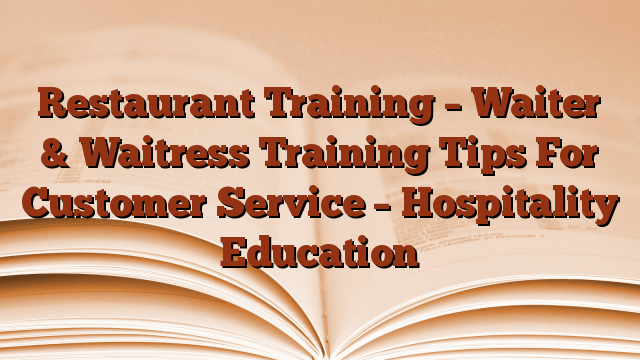Did you know that about 14 percent of your customers won’t return to your store because of the quality of food and 68 percent because of the quality of service? So doesn’t it make sense to train your waiters and waitresses to provide top-notch service to win your customers back every time?
To gain a competitive edge today, you need to do a lot more to get your restaurant on the “Favorite” list. One way is to personalize the service for each type of customer who visits your business. For example, the sales and service techniques used for a family with children differ from those that would be delivered to older customers. The same applies to business customers versus vacationers. It’s never safe to think that your restaurant service staff inherently understands these differences. If they are not trained, they most likely provide a consistent service.
Teach your waiters and waitresses to be attentive and follow these tips to assess your customers’ needs:
• Time limit (free time or limited in time)
• Mood (celebratory, romantic, stressed)
• Age group (children, adolescents, baby boomers, seniors, geriatrics)
• Purpose of the visit (social, private/intimate or business)
•Gender: Male, Female)
Because about 80 percent of communication is mediated through facial expressions and verbal and non-verbal body language, as opposed to actual words, teach your service team to focus on the following areas:
•Verbal language (inflection, rate, inflection, speech, pronunciation and grammar)
•Body language (eye contact, facial expressions, gestures and movement)
Watch for telltale signs a customer is in a hurry, such as For example, checking the time, looking around or turning around, speaking quickly, crossing your arms, or tapping your fingers. Also, pay close attention to the image of your customers (e.g. clothes, accessories, hair, makeup, etc.). This can also give you plenty of clues as to their dietary needs.
Here’s an exercise to share with your service team. It lists different types of customers and ways to customize the service for each customer category. Review this exercise with your wait staff at the restaurant during a pre-shift meeting or company training session.
Customer types and service suggestions:
1. Celebrations
– Since celebrating customers usually have larger budgets, suggest higher-priced items along with party-themed food/drinks and a cake to mark the occasion
– Congratulate the celebrating customer and focus on their main event
– Be social unless you are serving a couple who want privacy
2. Older
– Since many elderly customers have limited income, guide them to value-based foods and recommend light, soft and less spicy foods
– Be patient and speak slowly, project your voice and listen carefully
– Refrain from actions that could be construed as patronizing or treat them like children
3. family (with children)
– Do you offer high chairs and booster seats
– Be prepared to suggest kids’ favorites and easy-to-eat finger foods
– Offer something to grab the child’s attention (playbooks, crayons, crackers)
– Be patient while the family orders and allow children to place their own orders
– Sincerely compliment the client on their children
– Ask the child child-friendly questions
-Place drinks where there is less chance of spilling and remove obstructions (e.g. vases and centerpieces).
-Clean up spills quickly and keep the area clean
-Supply extra napkins
4. Romantic couple
-Guide the pair to an alcove or secluded area for privacy when seated
– Suggest higher priced items along with wines, champagne and exotic desserts as romantic couples and first date people usually have bigger budgets
– Provide a highly organized and efficient service
– Minimize your conversation and give them privacy without hovering over them
5. Business
– Suggest higher priced items as many business people have business accounts and set allowances
– Suggest quick food and let them know if the selected order takes a long time to prepare when they are at a business dinner
– Provide a highly organized and efficient service and ensure your order is delivered promptly
– Minimize your conversation and give them privacy without hovering over them
Please note: when serving alcohol, train staff to look for signs of intoxication and avoid overselling alcohol. Teach your employees to refuse to sell alcohol to minors.
Other customer types include customers dining alone (the solo customer), customers with disabilities, teenage customers, customers in a hurry, first-time visitors, and customers dining in large groups/gatherings. Again, each different type of customer has “specific” service requirements. In addition to acknowledging the category that customers fall into, the above service suggestions are intended as recommendations and are not set in stone. Always make sure you fully assess each restaurant customer by closely observing their verbal and body language to determine how you can positively interact with them. Mike Owens, General Manager of Brick Oven LLC based in Topeka, Kansas, says, “Using the above examples in role-play scenarios is an extremely effective way to properly train your service teams…it helps them tailor the meaning of their service, instead of offering everyone the same ready-made service.”
“Service” is not just about bringing food and drink to the table – it gives the customer much more than he/she expects. Implementing a robust training program focused on personalizing service will set you apart from your competitors. Exceeding the needs of each individual customer with tailored service takes a little more time. However, it is worth the effort. When the customer wins, everyone wins and it’s a triple game – more money for you, more tips for your service staff, and happy customers who become loyal customers and refer their friends to your business.
Thanks to Pam Simos | #Restaurant #Training #Waiter #amp #Waitress #Training #Tips #Customer #Service #Hospitality #Education

Leave a Reply